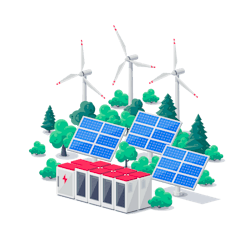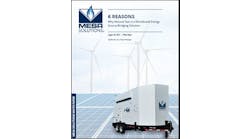Microgrid Benefits: Eight Ways a Microgrid will Improve your Operation … and the World
Eight microgrid benefits
1. A microgrid improves electric reliability
Among microgrid benefits, electric reliability has gotten the most attention since 2012 when Superstorm Sandy knocked out power to about 8 million electric customers in 15 states and the District of Columbia. Some outages lasted two weeks or more. People suffering in the darkness noticed that neighboring buildings still had their lights on. Those were facilities with microgrids.
Power outages aren’t only an inconvenience, they can be dangerous. When a Manhattan hospital’s backup generators failed during the storm, medical personnel had to evacuate ill babies by carrying them down long, dark flights of stairs as they manually pumped air into their lungs.
Microgrids keep the power flowing by disconnecting — or islanding — from the central grid when it begins to fail. The microgrid’s generators, and possibly batteries, then serve the microgrid’s customers until power is restored on the central grid.
2. A microgrid enhances resilience/recovery
Closely related to electric reliability is the idea of energy resilience. While reliability is about keeping the power on, resilience describes the ability to avoid power outages in the first place or to recover quickly if they do occur.
Resilience is also among the microgrid benefits that came to the fore following Superstorm Sandy. Its importance has been underscored in a series of lesser storms since.
In some cases, a microgrid immediately restores power to an entire building or operation, leaving occupants barely aware a disturbance occurred.
In other cases, a microgrid is programmed to restore only critical services within a facility. So a college campus, for example, might configure its microgrid to restore power to research labs and dining halls, but perhaps not swimming pools or peripheral academic offices. With critical operations up and running, the university can maintain a minimal and crucial level of service. Once the central grid is repaired, the facility can resume normal operations more quickly because it did not have to shut down completely.
What is a microgrid?
Utilities are now investigating installing microgrids for their central headquarters so that they can restore power faster to their customers during a massive outage. The utilities would coordinate workers and information from these electrified command centers.
3. A microgrid can lower energy costs for consumers and businesses
Microgrids can both reduce costs and provide a revenue stream for their customers. They reduce costs through the efficient management of energy supply. They supply revenue by selling energy and services back to the grid. This gives consumers a new kind of control in energy markets. They no longer just consume energy but also can produce and control it through their microgrids. Such customers are called prosumers.
Microgrids can earn revenue by providing ancillary services to the central grid. Ancillary services provide support functions for the grid, such as frequency control and spinning reserve.
Advanced microgrids also are adept at leveraging energy pricing. Electricity prices fluctuate throughout the day based on expected and historical demand. An advanced microgrid controller, known as the brain of the system, can leverage this fluctuation on its customers’ behalf. The microgrid does this by orchestrating the play of its assets with the rise and fall of electric pricing on the grid. When demand for grid energy is high and grid prices increase, the controller may signal the microgrid to use more of its own resources to avert paying the higher prices. If the microgrid has excess capacity, it may sell it back to the grid.
Because it uses its assets to maximize value over time, the microgrid serves its customers with both short- and long-term pricing planning. The extent to which it can do this, however, will depend on the sophistication of the microgrid controller and regional wholesale market rules.
Microgrids also can gain economic benefit by joining utility demand response programs or by participating in state and federal clean energy programs, such as state renewable portfolio standard initiatives or federal production tax credits. Some states have grant programs specifically for microgrids.
In areas where electricity costs are high — such as the Northeast and California — microgrids may be able to consistently provide energy at a lower cost. Microgrid customers then receive benefits, such as reliability and cleaner energy, yet pay lower prices for energy.
4. A microgrid improves the environment and promotes clean energy
Many businesses and communities establish clean energy goals to conserve energy and reduce the environmental impact of their power generation.
Microgrids can employ a wide range of green power production technologies. These include solar, wind, fuel cells, combined heat and power (CHP) plants, and energy storage technologies. Natural gas generators, used in many CHP plants, fall on the cleaner side of fossil fuels.
Microgrids integrate these renewables into the energy mix intelligently. They seamlessly balance the variable output of renewable energy with traditional generation assets. In doing so, the microgrid overcomes the downside of solar and wind energy, which is that they only generate power when the wind blows or sun shines. With no human intervention, a microgrid can tap into other resources when renewable energy is unavailable.
Advanced microgrids can also be programmed to achieve specific sustainability goals, such as use of the lowest carbon resources, to the maximum extent possible.
5. A microgrid strengthens the central grid
In addition to serving its own customers, a microgrid benefits neighbors as well when it’s used to strengthen the broader electric grid.
It does this in a few ways. One is by augmenting normal grid operation; for example, by participating in demand response programs or providing ancillary services.
Microgrids also can help ease strain on the central grid during periods of peak demand. They act as an additional resource grid operators can call upon during these periods.
The use of microgrids also averts line loss — the dissipation of electricity as it travels over wires. Microgrids are built close to the customers they serve, unlike large central power plants that may have to push their electricity hundreds of miles to reach their customers. Less line loss means we use more of the electricity we produce. In doing so, we avert the need to build more power plants and transmission lines to serve the central grid.
In fact, because microgrids can be less expensive to build and maintain than new grid substations, transmission lines or other grid infrastructure, they can act as “non-wires alternatives” — a resource built to improve reliability in lieu of more expensive grid repairs or upgrades.
6. A microgrid bolsters cybersecurity
A massive ransomware attack in May 2017 heightened worldwide concern about cybersecurity. Affecting 150 nations, the malware infected hundreds of thousands of businesses and institutions from British hospitals to FedEx in the US.
The US power grid has not been inflicted with a cyberattack that causes loss of power, but many experts are concerned about its vulnerability and are taking proactive measures. Installing microgrids is among them.
Military installations and utilities have taken keen notice of cybersecurity. For example, Ameren Illinois has developed a 1.475-MW project that is one of the most technologically advanced utility-scale microgrids in North America. Ameren is the first utility to install a military-grade cybersecure microgrid controller. In addition to advanced controls, the microgrid includes wind, solar, natural gas and energy storage.
The distributed architecture of a microgrid makes it more resistant to cyberattack. Should one generator be attacked, the microgrid has other power sources to rely on.
7. A microgrid brings economic value to society
Microgrids offer economic value to society in several ways. First, they avert loss of product and workdays during a power outage. Second, they attract high quality employers to a region. Third, as local energy plants, they keep jobs within the community.
By islanding from the grid during a power outage — and continuing to supply customers via on-site generators — microgrids avert significant economic loss. Businesses do not have to close; workers can get to their jobs.
Power outages are costly, especially to research facilities, data centers, manufacturers and grocery stores that lose product or services.
The cost of outages to the US economy ranges from $25 billion to $70 billion annually, depending on the number of storms, according to a Congressional Research Service study. Just a 30-minute interruption could cost a medium or large business or factory more than $15,000.
Given how expensive outages are to business, it is no surprise that enterprises dependent on premium power are attracted to communities with microgrids. By offering reliable power, these communities can attract high quality employers, such as data centers and pharmaceutical manufacturers.
It’s also important to note that the construction and operation of the microgrid creates local jobs. The community is not using power from a plant hundreds of miles away. As local energy, a microgrid benefits the local economy directly.
For all of these reasons, some communities now make microgrids part of their economic planning.
8. A microgrid improves community well-being
When a storm or other disaster knocks out power, at best it’s an inconvenience; at worst it’s a health and safety threat, especially if critical facilities cannot operate. As a result, more and more communities are installing microgrids to serve hospitals, police stations, fire departments, communications centers and wastewater treatment plants.
The geographic region served by the microgrid becomes an island of power. Sometimes shelters, grocery stores and gas stations are included within the microgrid’s service area. The neighborhood becomes a place of refuge, where community members can come to buy food, get clean water, charge cell phones and gas up cars.
Some communities provide microgrids for public housing where residents are restricted in their ability to evacuate during an emergency. Others protect the power supply to direct care providers such as homeless shelters, nursing homes and medical satellite facilities.
Here are just three examples of how a microgrid benefits society:
- Solar microgrids in Africa and India provide rural electrification and economic development to areas where no electric grid exists — or none with reliable power.
- Princeton University’s microgrid kept the lights and heat on while most of New Jersey was dark and chilly during Superstorm Sandy. First responders came there to get warm and share a pot of coffee.
- Vested in sustainability, Seton Healthcare Family in Austin, Texas, wanted to marry energy reliability with its sustainability goals. To meet both needs, Seton chose to power its new medical facility with a CHP plant microgrid that would not only provide power, but also sustainably capture waste heat from the combustion process to provide district heating.
Conclusion
A microgrid benefits its customers and society in many ways. It keeps the lights on when the central grid fails. It offers a way to upgrade the distribution grid, harden infrastructure and protect vulnerable communities. Through sophisticated, automated energy management, a microgrid can bolster clean energy use and can create economic value for customers — as well as the broader grid. And, finally, using a microgrid promotes local control, or what some call the democratization of energy and the rise of the prosumer.
Want to learn more about microgrids? Subscribe to the free Microgrid Knowledge Newsletter.







